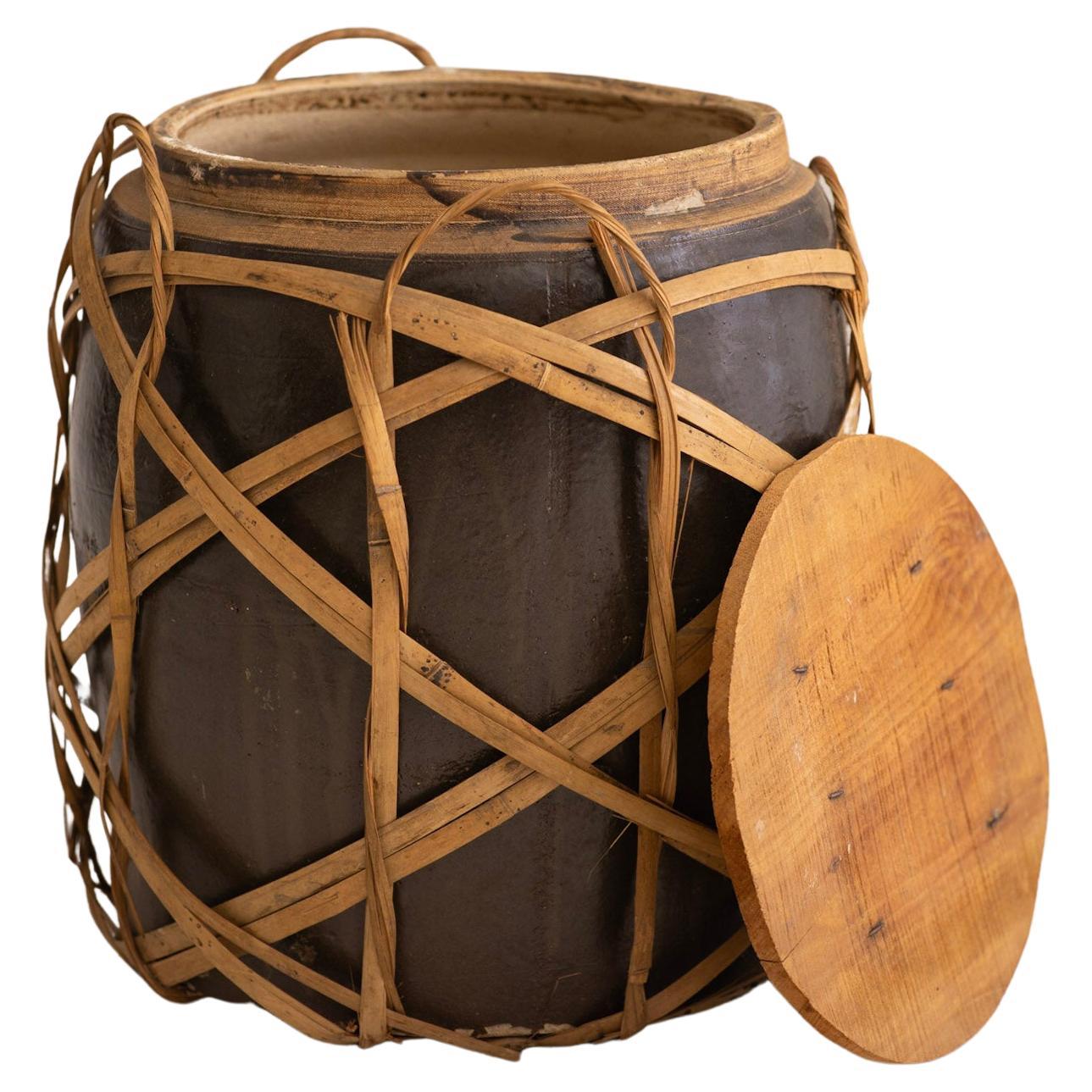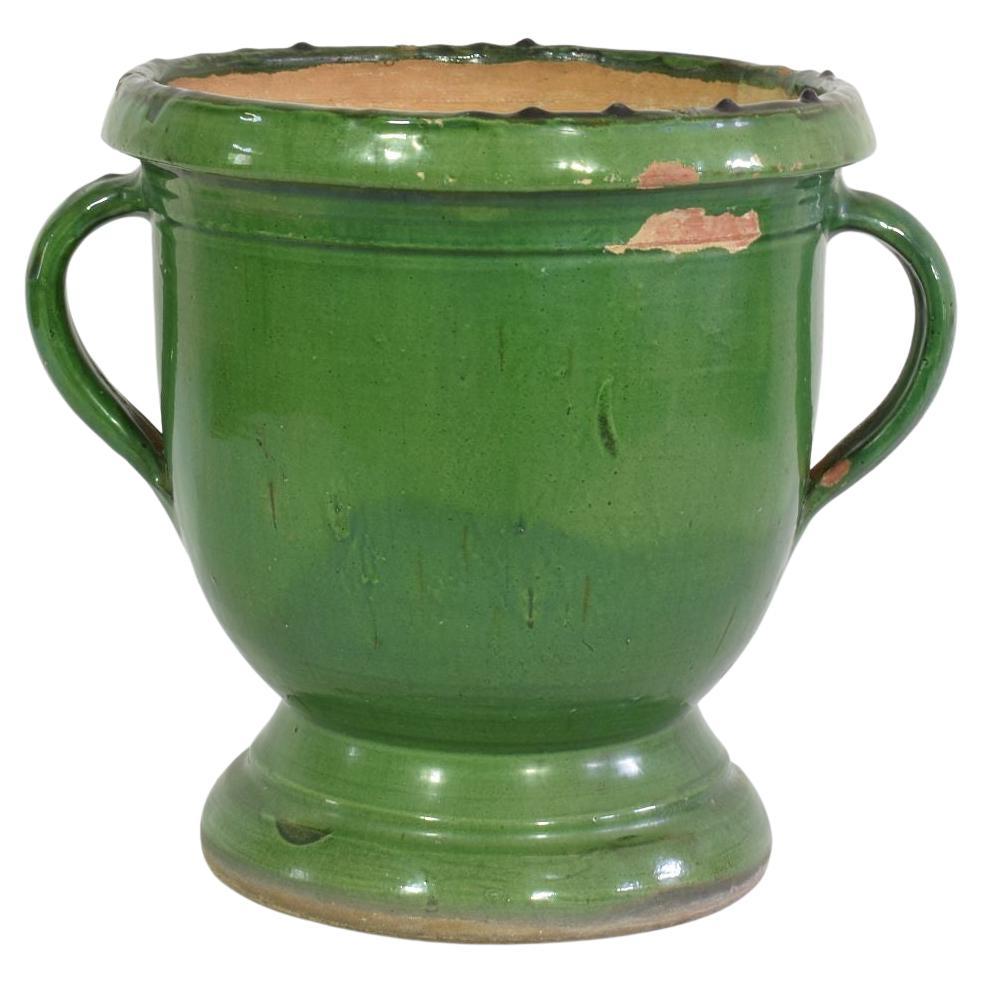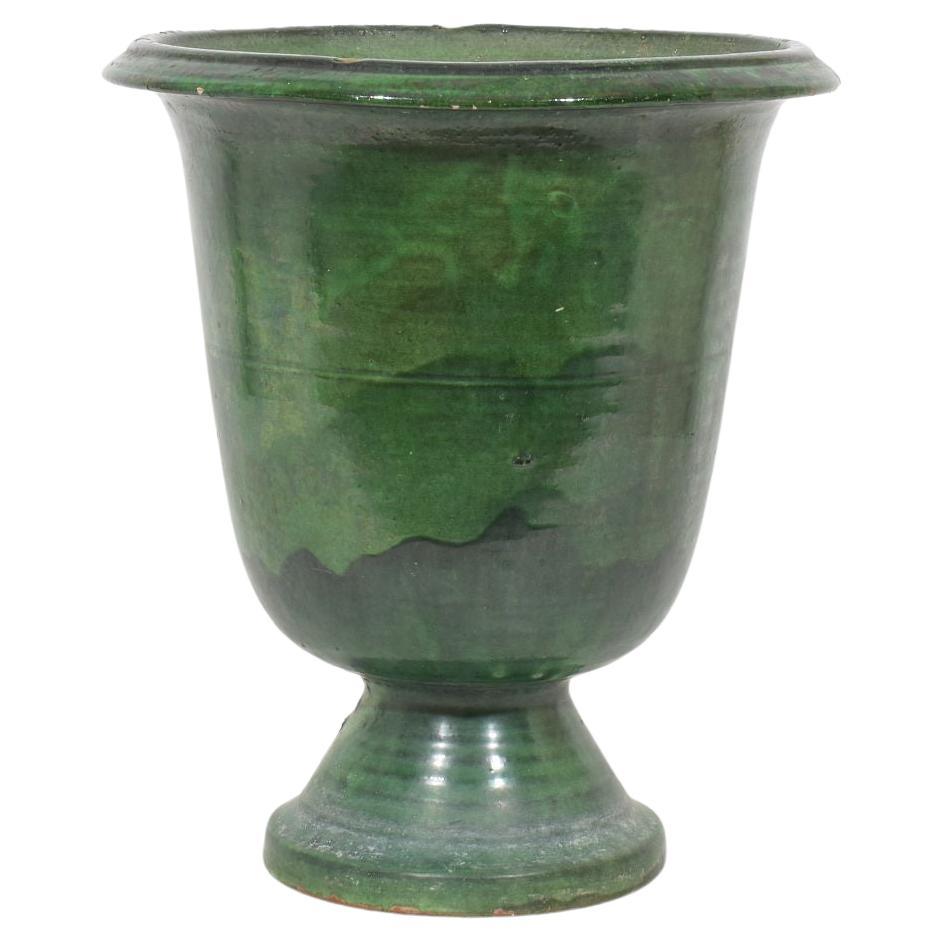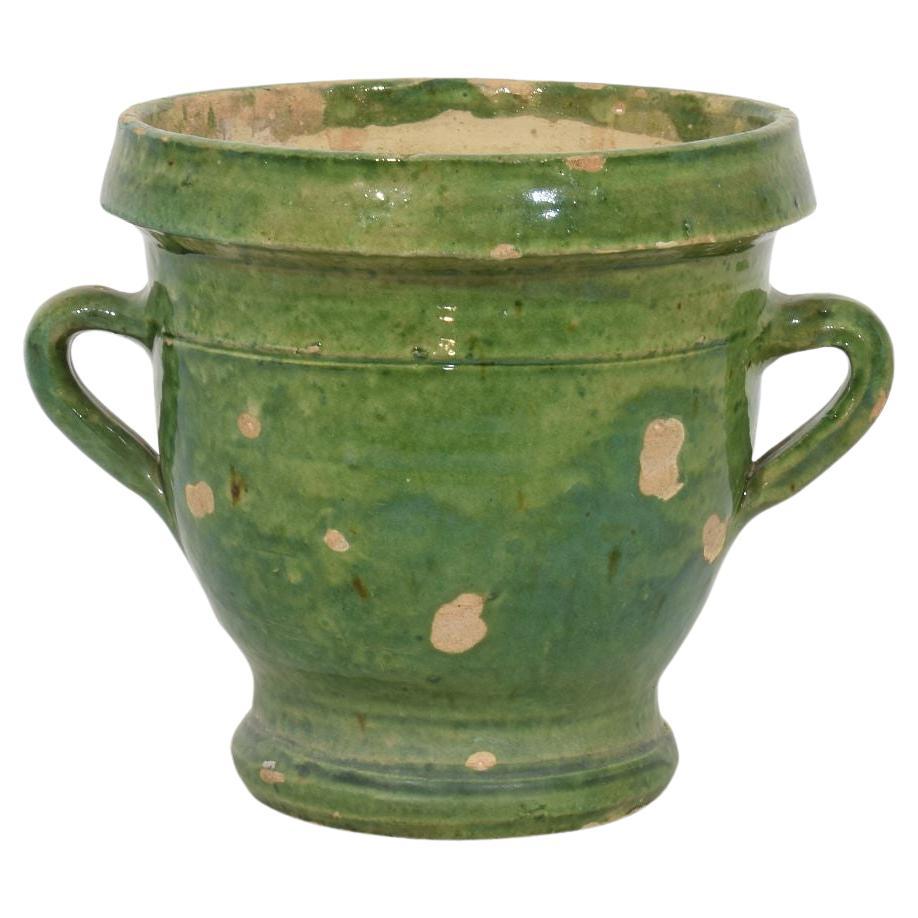Items Similar to Set of Ten Original Mid-Century Earthenware Terracotta Planter Pots, 1950s
Want more images or videos?
Request additional images or videos from the seller
1 of 20
Set of Ten Original Mid-Century Earthenware Terracotta Planter Pots, 1950s
About the Item
Original midcentury earthenware terracotta pots, approximately 5.3 inches/13.5cm diameter and 5 inches/13cm high with lovely colour variations (see images).
These pots were produced in Australia in the 40s/50s/60s by local Melbourne brickworks using rough textured brick clay. They were used in the horticultural industry, before the widespread introduction of plastic, crafted in a press mould, controlled by hand. There are many production marks, some include fingerprints.
These are the oldest Australian-made earthenware pots we've seen. The finish is rustic and the pot walls are thick. They've been in use for over 50 years, so there is plenty of wear and patina, natural earthenware colour variation and some slight size and shape variation.
We love these for household use or to display specimen succulents and bulbs. Hard to find in these quantities, particularly for older greenhouses where traditional natural materials are preferred. Please talk to us about your needs for bulk orders. At start of listing, there are over three hundred available in this size, in varying condition.
See our own images taken in 2007 at the Orto Botanico di Padova, in the northeastern part of Italy. It was founded in 1545 by the Venetian Republic and is the world's oldest academic botanical garden in continuous use. Every spring, pots of this style are arranged in rows on both sides of the main entrance, to display specimen plants from the glasshouses. The images show the same style and roughly same size pot.
This listing is for Grade A pots. They may have some minor chips to rim or base. All have been checked, no fractures. They have been scrubbed and heat treated to destroy fungal and bacterial organisms. Tiny traces of soil may remain in the grain.
- Dimensions:Height: 5.12 in (13 cm)Diameter: 5.32 in (13.5 cm)
- Sold As:Set of 10
- Style:Mid-Century Modern (Of the Period)
- Materials and Techniques:
- Place of Origin:
- Period:
- Date of Manufacture:1955
- Condition:Wear consistent with age and use. Minor losses. We've selected only those in sound condition. Flaws may include chips to rim and/or foot, drainage holes chipped, production flaws inside some rims look like a crack, however, are not structural. Colour variation. Patina. Soil ingrained. Moss patina.
- Seller Location:Melbourne, AU
- Reference Number:1stDibs: LU2656326503242

About the Seller
5.0
Vetted Seller
These experienced sellers undergo a comprehensive evaluation by our team of in-house experts.
Established in 2013
1stDibs seller since 2017
138 sales on 1stDibs
Typical response time: 1 hour
- ShippingRetrieving quote...Ships From: Melbourne, Australia
- Return PolicyA return for this item may be initiated within 14 days of delivery.
More From This SellerView All
- Zaccagnini Majolica Planter, circa 1950By Urbano Zaccagnini, Mario BandiniLocated in Melbourne, AUA handcrafted plant pot holder by the Zaccagnini pottery. This lovely piece is styled as a cylinder of plain white columns under a plain edge, sporting two highly detailed bunches of...Category
Vintage 1950s Italian Mid-Century Modern Decorative Baskets
MaterialsTerracotta
- Pair Rare John Campbell Terracotta Chinoiserie Planters or Umbrella StandsLocated in Melbourne, AUAn exceptionally rare pair of John Campbell planter pots. The design is attributed to John Cambell's son, Rupert John Campbell. John Campbell produced decorative pots at his brick works and pottery in Launceston, Tasmania from 1880 until 1975. Rupert John inherited his father's works and was a skilled artisan and potter. He developed presses for decorative pottery. This beautiful pair of jardinières likely date to the early 1900s. They were passed down through three generations. The original owner gave them to her son. In the 1980s the (then elderly) son gifted them to a friend (the last owner before this sale). At the time they received them they were made aware of their age and rarity. Now, another forty years later, they are potentially the only pair in existence. Only one similar John Campbell un-glazed terracotta 'umbrella stand' can be found on record. It was sold in 2008 in Tasmania, at a 'Fine Colonial Decorative Arts' auction run by Mossgreen Auctions, a reputable auction house, though since closed. I can find no other reference to this model, except an acknowledgement of the existence of an un-glazed terracotta umbrella stand, in the definitive record of Campbell's work by Kevin Power, 'John Campbell Pottery: Recollections and Collections' published 2014. These are of the same design and size but were manufactured with drainage holes in the base. They were clearly decorated using a press but the clay slabs were pushed into the press by hand. The interior of each pot shows the marks of hammers used to force the clay into the face of the press pattern. They have a hand-crafted appearance, with hand finished mould lines to each side and there are pressing faults apparent in various areas of the pattern. Tasmania was notably independent in production of most household goods, due to the isolation of the colony right up until the turn of the 19th century. Being at the farthest reaches of the British Empire, settled as a penal colony, with a relatively low consumer population, it was not a market for the high-volume import of domestic goods. As a consequence, household wares and decorative pieces produced in Tasmania through the 19th century represent a wholly independent category of Australian colonial design, production and craft. These pots are highly collectable and scarce artifacts of one of Tasmania’s earliest industries. In aesthetic terms, many Tasmanian artifacts are notable for following British, Georgian and Victorian fashions but with a colonial character of their own devising. Local characteristics became a stronger feature of Tasmanian decoration over time. Note the classical Georgian/Victorian chinoiserie motif of a bird foraging among rushes. In this case, the local interpretation depicts a Brolga (the largest Australian wetland bird) foraging amongst native Australian reeds and water lilies. Another of the things that sets early Tasmanian artifacts apart is the way in which necessity forced artistic production in pottery to be less refined than that of their British counterparts. A broad range of products had to be produced to meet local requirements, often by a single producer. John Campbell’s pottery is a great example of this practical necessity. It produced everything from industrial drainage pipes and bricks to household pottery and decorative items, all from a relatively small family run factory. Their domestic wares were so well trusted and appreciated that they by the 1940s they made their way all over the mainland of Australia. Under these circumstances, the refinement of decorative technique was not as great a priority as utility, consistent quality of production and durability. As a consequence, Australian colonial works and their early 20th century descendants such as these pots, are hugely appealing. They have an idiosyncratic and vernacular appearance, with British and European stylistic trends of their day overlaying a base of inventiveness, local interpretation and sturdy functionality. We hope you can appreciate the rarity and significance of this well-preserved pair of planter...Category
Vintage 1930s Australian Chinoiserie Planters, Cachepots and Jardinières
MaterialsTerracotta
- Antique Art Nouveau Torhout Flemish Belgian Earthenware PotteryLocated in Melbourne, AUAn Art Nouveau Flemish earthenware vase from Torhout, dating to the early 1900s. The simple, attractive shape and incised design are typical of the...Category
Antique 1890s Belgian Art Nouveau Vases
MaterialsEarthenware
- Large Wide Based Brutalist Middle Eastern Earthenware Lamp Base, 1970sLocated in Melbourne, AULarge and wonderfully shaped earthenware lamp is fully wired, tested and tagged safe for use. It’s a coil pot construction in the style of Dan Arbeid. The wid...Category
Vintage 1970s Israeli Brutalist Vases
MaterialsEarthenware
- Very Large San Marino Bottle Vase Smalto Roccia Glaze Italy 1950sBy San Marino PotteryLocated in Melbourne, AUAn unusually large example of San Marino tourist pottery with 'Smalto Roccia' or 'Lava' glaze. The brightly colored blue panel illustrates a Mediterran...Category
Vintage 1950s Italian Mid-Century Modern Bottles
MaterialsClay
- Lady Head San Marino Boat Vase Smalto Roccia Glaze Italy 1950sBy San Marino PotteryLocated in Melbourne, AUA lavish example of San Marino pottery, with typical 'Smalto Roccia' or 'Lava' glaze. A boat vase with a central red panel depicting typical lady head with flowers in sgrafitto decor...Category
Vintage 1950s Italian Mid-Century Modern Vases
MaterialsClay
You May Also Like
- Midcentury Italian "Ro Ro" Variegated Terracotta Planter Pot, Italy circa 1970sBy Carlo ScarpaLocated in Miami, FLUnique Mid-Century Modern Italian planter or flower pot, rendered in variegated or marbleized terracotta in tones of buff, brown, and beige. Italy, circa 1970s.Category
Mid-20th Century Italian Mid-Century Modern Planters and Jardinieres
MaterialsCeramic, Pottery, Terracotta
- Vintage Wicker Wrapped Earthenware Vessel PlanterLocated in Brooklyn, NYVintage earthenware vessel with wicker basket and wooden lid. Unknown provenance. Likely used as jug to hold or age food or alcohol. Similar style to that of Martaban Pottery. Large ...Category
Mid-20th Century Unknown Rustic Planters, Cachepots and Jardinières
MaterialsClay, Wood, Wicker, Pottery, Earthenware
- French 19th Century Green Glazed Earthenware Castelnaudary PlanterLocated in Buisson, FRBeautiful glazed earthenware castelnaudary planter, France, circa 1850-1900, Good condition.Category
Antique 19th Century French French Provincial Planters, Cachepots and Ja...
MaterialsEarthenware
- Spanish 18th Century Black Terracotta Urn, PlanterLocated in Atlanta, GAA rare and stunning black terracotta urn from the Girona area of Spain. Beautiful patina and condition. A wonderful piece for any interior of exte...Category
Antique Late 18th Century Spanish Planters and Jardinieres
MaterialsTerracotta
- French 19th Century Green Glazed Earthenware Castelnaudary Planter / VaseLocated in Buisson, FRBeautiful glazed earthenware castelnaudary planter, France, circa 1850-1900, Good condition.Category
Antique 19th Century French French Provincial Planters and Jardinieres
MaterialsEarthenware
- French Small 19th Century Green Glazed Earthenware Castelnaudary PlanterLocated in Buisson, FRBeautiful small glazed earthenware castelnaudary planter, France, circa 1850-1900, Good weathered condition.Category
Antique 19th Century French French Provincial Planters, Cachepots and Ja...
MaterialsEarthenware
Recently Viewed
View AllMore Ways To Browse
Original Mid Century
Australian Mid Century
Australia Mid Century Modern
Australian Mid Century Modern
Mid Century Earthenware
Textured Pots
Terracotta Pots Used
Terracotta Pot Used
Used Terracotta Pots
Terracotta Old
Italian Earthenware
Australian 1950
Mid Century Planter Pot
1950s Australia
Earthenware Pot
Modern Planter Pot
Planter Textured
Garden Planters Set





